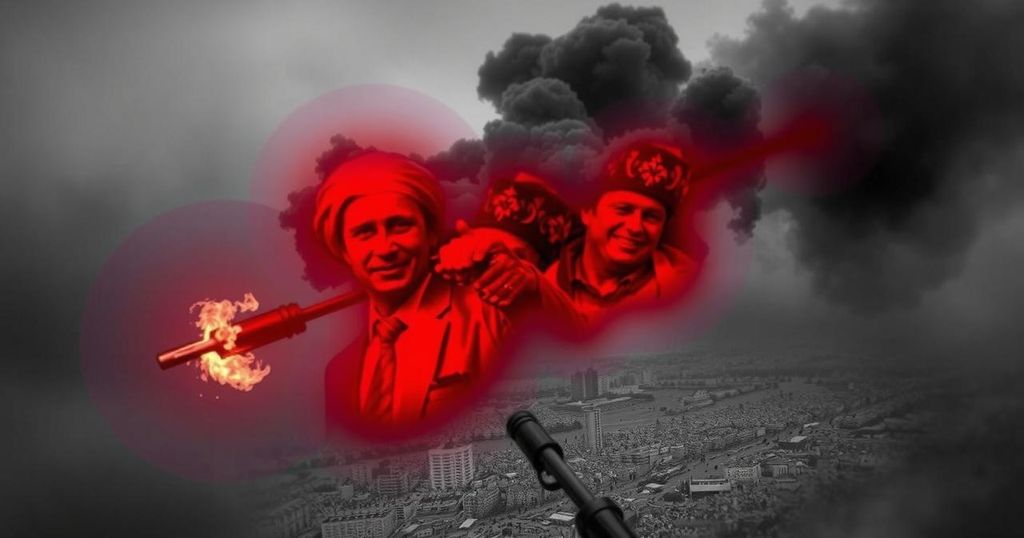The situation in Syria is evolving rapidly; Bashar al-Assad’s regime faces unprecedented challenges from rebel forces. Russia and Iran, critical supporters of Assad, are distracted by other conflicts, leaving the regime vulnerable. The significant events of the past week could reshape the Middle East’s geopolitical landscape, particularly affecting Iranian and Russian interests in the region.
The situation in Syria remains tumultuous, with significant upheaval affecting the regime of President Bashar al-Assad. Recently, a rebel faction has made considerable advances, capturing territories and even breaching the capital, Damascus. This rapid change indicates a decline in Assad’s authority, transforming Syria’s power dynamics and presenting major challenges for key supporters like Russia and Iran, who have historically backed the Assad administration since the uprising against his regime began in 2011.
Both Russia and Iran find themselves in a precarious position amid this chaos. For Russia, Syria represents its most vital ally in the Middle East, providing access to crucial military bases – a naval facility in Tartous and an air base in Latakia. Such strategic assets allow Moscow to maintain influence in the Mediterranean region. Conversely, Iran’s support for Assad has been paramount for establishing a Shia corridor from Iran through Syria to Lebanon. The fall of the Assad regime would disrupt this connection and diminish Iran’s leverage against Israel and Saudi Arabia.
Bashar al-Assad’s grip on power has weakened, significantly following a brutal crackdown on early protests that initiated a civil war. Although the regime seemed resilient a fortnight ago, recent insurgent advances suggest otherwise. These developments were bolstered by the emergence of Hayat Tahrir al-Sham, a potent rebel group positioned in northern Syria, which capitalized on the tactical withdrawal of supportive forces like Russia and Hezbollah, which were preoccupied with other conflicts.
The attention of Russia has gravitated towards its ongoing conflict in Ukraine, limiting its capacity to intervene in Syria. Moreover, Iran’s current focus on countering Israeli actions further dilutes its ability to project power in Syria. The distraction experienced by both nations poses a vulnerability for Assad’s regime, amplifying the threat from determined rebel factions.
As a result, the recent offensive by Hayat Tahrir al-Sham has sent shockwaves throughout the region. Its effectiveness signifies a remarkable shift, as a single operation has profoundly altered the strategic landscape of the Middle East. However, the future trajectory of these developments remains uncertain, leaving analysts and policymakers grappling with the implications of this evolving situation.
The chaos in Syria stems from a decade-long conflict that began with civil unrest against President Bashar al-Assad’s regime. His brutal response to protests in 2011 sparked a civil war that drew in various international powers, including Russia and Iran, who supported Assad to maintain their influence in the Middle East. The conflict has seen the rise of multiple factions, including Sunni rebel groups and Shiite militias, leading to a complex proxy war involving regional and global players. Recent shifts in power dynamics, particularly by rebel forces like Hayat Tahrir al-Sham, mark significant turning points that impact both regional stability and the strategic interests of Russia and Iran.
In conclusion, the turmoil in Syria marks a pivotal moment for both the Assad regime and its foreign allies, primarily Russia and Iran. As rebel forces gain ground amidst the distractions faced by Assad’s supporters, the long-standing geopolitical landscape of the Middle East is undergoing seismic shifts. The fall of Assad could destabilize the region further, reducing Iranian influence and challenging Russian military positioning. The outcomes of these events carry substantial implications not only for Syria but also for the broader balance of power in the Middle East.
Original Source: www.abc.net.au






